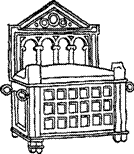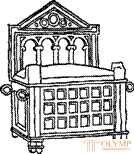
After the division of the Roman Empire (395) in its eastern part (the Balkans, Western Asia, Syria and Egypt), the Byzantine Empire (Byzantium) was formed with its capital Constantinople.
Byzantium is one of the most significant world civilizations. Its state structure, religion, culture and art attracted the attention of many European countries, including Kievan Rus. Relations of Byzantium and Russia in trade, politics and culture were very active.
Byzantine art, which developed over a millennium (from IV to XV century), left numerous architectural monuments, works of applied art (fabrics, enamels, miniatures), but genuine Byzantine furniture, in essence, has not survived. About Byzantine furniture can be judged by its images on ivory products and in church books and chronicles, decorated with miniatures.
Some items of Byzantine furniture are preserved. on the territory of Italy in the ancient churches of Teramo, Bari Monte Sant'Angelo and Canossa in the form of chairs and thrones for the higher ranks of the clergy. They are massive marble armchairs inlaid with gold and colored stones. The sides of the chairs are decorated with images of fantastic animals and birds.
How the Byzantine furniture looked like, we can mainly judge by the illustrations for the books, by the miniatures. One such example is the so-called chair of St. Peter (Fig. 1). Here prevails architectural interpretation of forms. For example, the back is solved as the facade of a building: it is completed with a gable, includes an arcade. Typical for the Byzantine thrones and chairs are deaf chested bottom.
Furniture made of wood. Carved supports and backs were common. Forms of Byzantine furniture in comparison with the Greco-Roman significantly simplified. The artistic effect was achieved by richly decorating products with color painting, gilding, carving, ivory inserts, inlay of smalt, precious metals and stones.
In solving the interior and furnishing of palaces and dwellings, Byzantines maintained and continued the Roman tradition, but the influence of Oriental luxury increased: they used magnificent silk fabrics with rich patterns from which they made curtains, tablecloths, bedspreads and soft pillows for chairs, chairs and benches; low and soft ottomans and sofas.
Christian motifs were widely used in the ornament: the monogram of Christ, the image of a pigeon, fish, lamb, peacock, grape brush, wheat ears, laurel wreath, olive branch and palm leaf. Acanthus leaf and palmette were borrowed from Greek art.

Fig. 1. The chair of sv. Peter, VI century.
Despite the fact that the Byzantine style did not bring anything fundamentally new to the development of the art of furniture, it had a strong influence on the styles of the Middle Ages, especially the Romanesque style, thanks to its ornamentation and form stability.
In modern historical science, the Middle Ages called the era of feudalism, which came to replace the slave system. In Europe, it lasted for several centuries - from the fall of the Roman Empire (the end of the 5th century) to the bourgeois revolutions of the 17th — 18th centuries. In the history of art, the period of the Middle Ages is considered complete on the verge of the 14th — 15th centuries, when the Renaissance culture emerged. On the one hand, medieval art influenced the church, and on the other, folk art.
Что бы оставить комментарий войдите
Комментарии (0)